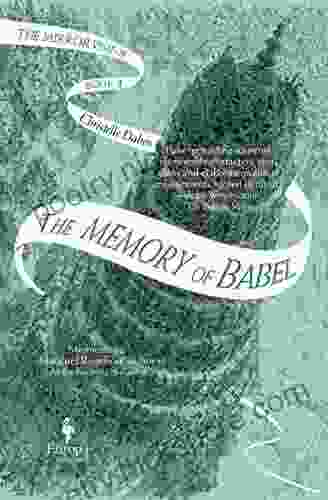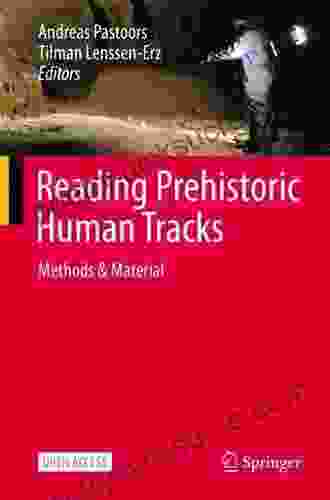Unveiling the Footprints of Time: Reading Prehistoric Human Tracks Methods and Materials

The study of prehistoric human tracks offers us a unique glimpse into the lives and behavior of our ancient ancestors. These tracks, preserved in sediment and rock formations, provide invaluable insights into their locomotion, ecology, and social interactions. To unlock the secrets hidden within these tracks, researchers employ various methods and materials, each meticulously designed to decipher the stories they hold.
Methods of Prehistoric Human Track Analysis
1. Surface Mapping and Photography
The first step in studying prehistoric human tracks is thorough surface mapping and photography. Researchers carefully document the location, orientation, and overall distribution of tracks using techniques such as hand mapping, total station surveys, and aerial photography. This creates a comprehensive record of the track site, providing a foundation for further analysis.
5 out of 5
| Language | : | English |
| File size | : | 62866 KB |
| Text-to-Speech | : | Enabled |
| Screen Reader | : | Supported |
| Enhanced typesetting | : | Enabled |
| Print length | : | 661 pages |
2. Casting and Molding
To preserve and study tracks in detail, researchers often create casts and molds. Casts are made by pouring a liquid material, such as plaster or resin, into the track impression. Once set, the cast can be removed from the site, providing an exact replica of the original track. Molds are created by pressing a flexible material, like silicone, into the track. The mold can then be used to create multiple casts, allowing researchers to share and study the tracks widely.
3. Photogrammetry
Photogrammetry is a technique that uses multiple photographs to create a precise 3D model of the track. By capturing images from different angles, researchers can generate a highly detailed digital representation. This model allows for accurate measurements, comparisons, and visualization of the track's morphology.
4. Geomorphological Analysis
The surrounding geological context of prehistoric human tracks provides valuable information about the environment in which they were made. Geomorphological analysis examines the sediment type, grain size, and depositional features to determine the age, depositional processes, and potential post-depositional modifications that may have affected the tracks.
Materials for Prehistoric Human Track Analysis
The choice of materials used in prehistoric human track analysis depends on the specific method employed and the characteristics of the tracks themselves. Here are some commonly used materials:
1. Plaster and Resin
Plaster and resin are widely used for making casts of human tracks due to their ability to capture fine details and preserve the original morphology. They provide a durable and accurate representation of the track for further study.
2. Silicone
Silicone is a flexible material used for creating molds. It easily conforms to the contours of the track, allowing for highly precise casts. Silicone molds can be used multiple times to create additional casts as needed.
3. Hydrocal and Dental Stone
Hydrocal and dental stone are gypsum-based materials that provide excellent surface detail and high strength. They are ideal for making casts of tracks that are delicate or require fine-grained analysis.
4. Photogrammetry Equipment
Photogrammetry requires specialized equipment, including a DSLR camera, a sturdy tripod, and a software suite for image processing and model generation. The camera should have a high resolution and a wide dynamic range to capture all the necessary details.
The methods and materials used in the study of prehistoric human tracks are essential for unlocking the secrets of our ancestors' past. Through surface mapping, casting, photogrammetry, and geomorphological analysis, researchers meticulously document, preserve, and interpret these ancient footprints. The materials employed, from plaster and resin to silicone and photogrammetry equipment, play a crucial role in ensuring the accuracy, detail, and preservation of the tracks. By harnessing these tools and techniques, we continue to expand our understanding of human evolution, migration, and behavior, one track at a time.
5 out of 5
| Language | : | English |
| File size | : | 62866 KB |
| Text-to-Speech | : | Enabled |
| Screen Reader | : | Supported |
| Enhanced typesetting | : | Enabled |
| Print length | : | 661 pages |
Do you want to contribute by writing guest posts on this blog?
Please contact us and send us a resume of previous articles that you have written.
 Fiction
Fiction Non Fiction
Non Fiction Romance
Romance Mystery
Mystery Thriller
Thriller SciFi
SciFi Fantasy
Fantasy Horror
Horror Biography
Biography Selfhelp
Selfhelp Business
Business History
History Classics
Classics Poetry
Poetry Childrens
Childrens Young Adult
Young Adult Educational
Educational Cooking
Cooking Travel
Travel Lifestyle
Lifestyle Spirituality
Spirituality Health
Health Fitness
Fitness Technology
Technology Science
Science Arts
Arts Crafts
Crafts DIY
DIY Gardening
Gardening Petcare
Petcare Sara Dyer
Sara Dyer William Goldman
William Goldman Douglas Perry
Douglas Perry Joshua Shifrin
Joshua Shifrin Patricia Ladis
Patricia Ladis Geryn Childress
Geryn Childress H Jerome Chapman
H Jerome Chapman Christopher Seddon
Christopher Seddon Heidi Kreider
Heidi Kreider Lily Dunn
Lily Dunn Breeda Bermingham
Breeda Bermingham Henry Dillon
Henry Dillon Angela Saini
Angela Saini Michael F Nenes
Michael F Nenes Steve Bennett
Steve Bennett Mishka Shubaly
Mishka Shubaly Ray Eye
Ray Eye Sarah Stodola
Sarah Stodola Peter Watson
Peter Watson Susan G Solomon
Susan G Solomon Cade Courtley
Cade Courtley Stefan Hollos
Stefan Hollos Dannah Gresh
Dannah Gresh James F Twyman
James F Twyman Graham Robb
Graham Robb Zach Davis
Zach Davis Sam Demas
Sam Demas Melvin Fitting
Melvin Fitting Judy Corry
Judy Corry Christopher T Coughlin
Christopher T Coughlin Josephine Mccarthy
Josephine Mccarthy Dr Sarita Uhr
Dr Sarita Uhr Charlene Beswick
Charlene Beswick George Lakoff
George Lakoff Margaret Rogerson
Margaret Rogerson Arcturus Publishing
Arcturus Publishing Annabel Streets
Annabel Streets Stan Gibilisco
Stan Gibilisco Anna Bright
Anna Bright Ann Mccallum Staats
Ann Mccallum Staats Nancy Marie White
Nancy Marie White Brian Daccord
Brian Daccord June Hur
June Hur Quinn Loftis
Quinn Loftis Bob Cary
Bob Cary Patrick Torsell
Patrick Torsell Miley Smiley
Miley Smiley Steven G Krantz
Steven G Krantz Melissa Mortenson
Melissa Mortenson Karen Bassie Sweet
Karen Bassie Sweet Sally Black
Sally Black Joanna Wells
Joanna Wells Janine Marsh
Janine Marsh Mikael Lindnord
Mikael Lindnord Tony Osgood
Tony Osgood Ellen Dugan
Ellen Dugan Victor Stringer
Victor Stringer Todd Radom
Todd Radom Elisabeth Haich
Elisabeth Haich Sara Wickham
Sara Wickham Caryl Phillips
Caryl Phillips Worley Faver
Worley Faver Neel Doshi
Neel Doshi Randy J Paterson
Randy J Paterson Suzanne I Barchers
Suzanne I Barchers Tyler Richards
Tyler Richards Julie Plagens
Julie Plagens Curtis Collins
Curtis Collins Zena Hitz
Zena Hitz Guy Windsor
Guy Windsor Stuart Tomlinson
Stuart Tomlinson Winton Porter
Winton Porter Nicholas Thomas
Nicholas Thomas Nicholas Clapp
Nicholas Clapp Steven Munatones
Steven Munatones Randall Fitzgerald
Randall Fitzgerald Melanie Dickerson
Melanie Dickerson Katie Krimer Ma Lcsw
Katie Krimer Ma Lcsw David Soucie
David Soucie Shelley Emling
Shelley Emling Dan Gardner
Dan Gardner Shawn Shallow
Shawn Shallow Eddie Jones
Eddie Jones Craig Ramsay
Craig Ramsay Finn Aagaard
Finn Aagaard Isaac Fitzsimons
Isaac Fitzsimons Dean Buonomano
Dean Buonomano Richard A Swanson
Richard A Swanson Omari Bouknight
Omari Bouknight Seth Stephens Davidowitz
Seth Stephens Davidowitz Ralph Cockburn
Ralph Cockburn Gloria Chadwick
Gloria Chadwick Charles Dickens
Charles Dickens Robin Esrock
Robin Esrock Joey Myers
Joey Myers John Murray
John Murray Julie Creffield
Julie Creffield Chronicle Books
Chronicle Books Peter Wacht
Peter Wacht Hill Harper
Hill Harper Lori L Tharps
Lori L Tharps Jay Spence
Jay Spence Michael Hodgson
Michael Hodgson Linda K Miller
Linda K Miller Zach Hunter
Zach Hunter Chase Hassen
Chase Hassen C W Farnsworth
C W Farnsworth Barb Musick
Barb Musick Paul Mendelson
Paul Mendelson Rutger Bregman
Rutger Bregman Jack Perconte
Jack Perconte Maya Van Wagenen
Maya Van Wagenen Michael Burnett
Michael Burnett Walter Mischel
Walter Mischel Margaret Jean Langstaff
Margaret Jean Langstaff Christine Hopfgarten
Christine Hopfgarten Steve Schwartz
Steve Schwartz Pradeepa Narayanaswamy
Pradeepa Narayanaswamy Susan Spicer
Susan Spicer Kendall Coyne
Kendall Coyne Jackie Bolen
Jackie Bolen Jennifer Kostick
Jennifer Kostick Ruby Mcconnell
Ruby Mcconnell Jackson Carter
Jackson Carter Les Livingstone
Les Livingstone Christelle Dabos
Christelle Dabos Gwen Mckee
Gwen Mckee Sandy Camillo
Sandy Camillo John Dunn
John Dunn Illysa R Foster
Illysa R Foster Boye Lafayette De Mente
Boye Lafayette De Mente Sally Annjanece Stevens
Sally Annjanece Stevens Margaret Paul
Margaret Paul Michael G Manning
Michael G Manning Michael Witwer
Michael Witwer Jemar Tisby
Jemar Tisby Louise Katz
Louise Katz L J Martin
L J Martin Naomi Tomky
Naomi Tomky John Yates
John Yates Jean Barbre
Jean Barbre Roger Hall
Roger Hall Darryl Belfry
Darryl Belfry Donna D Ignatavicius
Donna D Ignatavicius Harnarayan Singh
Harnarayan Singh Susan Straub
Susan Straub Trevor Hartman
Trevor Hartman Holly Chism
Holly Chism Noel D Justice
Noel D Justice Becky Wade
Becky Wade Mike Reilly
Mike Reilly W W Sawyer
W W Sawyer John O Sullivan
John O Sullivan Jay Allan
Jay Allan Adele Faber
Adele Faber Joy Dawson
Joy Dawson Paul Bloom
Paul Bloom Sheela Raja
Sheela Raja David Berry
David Berry Steven Yellin
Steven Yellin William P Young
William P Young Asker Jeukendrup
Asker Jeukendrup Livia Bitton Jackson
Livia Bitton Jackson Patricia Romanowski Bashe
Patricia Romanowski Bashe Peyton Curley
Peyton Curley Julian Of Norwich
Julian Of Norwich Harley Mcallister
Harley Mcallister Helge Kragh
Helge Kragh Ann Zaprazny
Ann Zaprazny Chris Gore
Chris Gore John Edwards
John Edwards Mordecai Orimiladeye
Mordecai Orimiladeye Scott P Sells
Scott P Sells Timothy P Schultz
Timothy P Schultz Nelson Dellis
Nelson Dellis Cathy Glass
Cathy Glass R K Agarwal
R K Agarwal Christina Henry De Tessan
Christina Henry De Tessan Barry Schwartz
Barry Schwartz Anna Quindlen
Anna Quindlen Steven Callahan
Steven Callahan Suzanne Girard Eberle
Suzanne Girard Eberle Horace Kephart
Horace Kephart Nisha Garg
Nisha Garg Anna Grafl
Anna Grafl Dave Whitlock
Dave Whitlock Richard A Ruth
Richard A Ruth J Scott Long
J Scott Long Sparknotes
Sparknotes Philip Reed
Philip Reed Rebecca A Moyes
Rebecca A Moyes Sally Connolly
Sally Connolly Luke Schumacher
Luke Schumacher Matthew Locricchio
Matthew Locricchio Caroline Miller
Caroline Miller Anna Crowley Redding
Anna Crowley Redding Anna Ivey
Anna Ivey Krista Marson
Krista Marson Rick Page
Rick Page Will Kurt
Will Kurt Ichigo Takano
Ichigo Takano H M Schey
H M Schey Gary Chapman
Gary Chapman Maggie Downs
Maggie Downs L A Cotton
L A Cotton Rebecca Carroll
Rebecca Carroll Rick Sparkman
Rick Sparkman Thomas A Garrity
Thomas A Garrity Malcolm S Thaler
Malcolm S Thaler Daniel Isberner
Daniel Isberner Reinhard Kleist
Reinhard Kleist Tarani Chandola
Tarani Chandola Scott Shupe
Scott Shupe Claire Walter
Claire Walter G Norman Lippert
G Norman Lippert Lina Beard
Lina Beard Eleanor J Sullivan
Eleanor J Sullivan Dave Hughes
Dave Hughes Christine Field
Christine Field Mark Matlock
Mark Matlock Kyung Won Chung
Kyung Won Chung Julian Havil
Julian Havil Illustrated Edition Kindle Edition
Illustrated Edition Kindle Edition Stacey A Shannon
Stacey A Shannon Neal Shusterman
Neal Shusterman Hanumant Deshmukh
Hanumant Deshmukh Emmett W Hines
Emmett W Hines Sharon Rowley
Sharon Rowley Jenna Evans Welch
Jenna Evans Welch Jennifer Dugan
Jennifer Dugan Chic Scott
Chic Scott Jennifer L Lopez
Jennifer L Lopez R A Salvatore
R A Salvatore Annalyn Ng
Annalyn Ng Joyce Meyer
Joyce Meyer Tara Haelle
Tara Haelle James Burke
James Burke Philip Gibson
Philip Gibson L J Smith
L J Smith Sharman Apt Russell
Sharman Apt Russell Anna Wood
Anna Wood Elizabeth Wissner Gross
Elizabeth Wissner Gross Sukhveer Singh
Sukhveer Singh Robert A Cook
Robert A Cook Justine Gregory Williams
Justine Gregory Williams John Pullen
John Pullen Tali Sharot
Tali Sharot Robert Gerver
Robert Gerver James C Scott
James C Scott Bob Labbe
Bob Labbe Marva Boatman
Marva Boatman Kennedy Achille
Kennedy Achille Todd Denault
Todd Denault Louis Van Dyke
Louis Van Dyke Lexi Ryan
Lexi Ryan Freddy Silva
Freddy Silva Jessa Stone
Jessa Stone Ford R Bryan
Ford R Bryan Ray Moynihan
Ray Moynihan Helen E Lees
Helen E Lees Steve Grant
Steve Grant Helen Adrienne
Helen Adrienne Lily Siou
Lily Siou Darcie Little Badger
Darcie Little Badger Richard C Schwartz
Richard C Schwartz Timothy Ellis
Timothy Ellis L Chapman
L Chapman John Dickson
John Dickson Ralph Waldo Emerson
Ralph Waldo Emerson Dan Vogel
Dan Vogel James C Zimring
James C Zimring Laurie Varga
Laurie Varga Annaka Harris
Annaka Harris Chris Fregly
Chris Fregly Ling Seto
Ling Seto Prime Hall
Prime Hall Mike Roberts
Mike Roberts Roy R Grinker
Roy R Grinker Roy M Wallack
Roy M Wallack M Terese Verklan
M Terese Verklan Jacqueline Winslow
Jacqueline Winslow Stephanie Cave
Stephanie Cave Ariel Dalfen
Ariel Dalfen Oskar Morgenstern
Oskar Morgenstern Ann Voskamp
Ann Voskamp John Van Wyhe
John Van Wyhe Linda Lewis Alexander
Linda Lewis Alexander Crystal Cook
Crystal Cook Alex Bromley
Alex Bromley Geoff Greig
Geoff Greig Julia Galef
Julia Galef Anna Della Subin
Anna Della Subin Dr Harper
Dr Harper Glen E Clarke
Glen E Clarke Bert Mendelson
Bert Mendelson Bernard Stiegler
Bernard Stiegler Bethany Saltman
Bethany Saltman P M Gilbert
P M Gilbert Richard Appleton
Richard Appleton Jacob Ward
Jacob Ward Robert A Conover
Robert A Conover Fumio Sasaki
Fumio Sasaki Stephen Tarsitano
Stephen Tarsitano Bella Forrest
Bella Forrest Susan M Schneider
Susan M Schneider Larry Semento
Larry Semento Junior Health Institute
Junior Health Institute Anna Flores Locke
Anna Flores Locke Sajni Patel
Sajni Patel Jenny Jacobs
Jenny Jacobs Kristian Berg
Kristian Berg Ben Shneiderman
Ben Shneiderman Bob Madgic
Bob Madgic Martin Meredith
Martin Meredith David Woods
David Woods Bren Smith
Bren Smith Julie C Meloni
Julie C Meloni Pierluigi Barrotta
Pierluigi Barrotta Barak A Bassman
Barak A Bassman The Pinnacle Review
The Pinnacle Review Fox Fisher
Fox Fisher Steve Olson
Steve Olson Richard Mcafee
Richard Mcafee Harold Davis
Harold Davis Peter Hathaway Capstick
Peter Hathaway Capstick Adil E Shamoo
Adil E Shamoo Johnny Chuong
Johnny Chuong Katharine Beals
Katharine Beals Peter Richmond
Peter Richmond Tim Young
Tim Young Kristen L Mauk
Kristen L Mauk J E Esslemont
J E Esslemont Charles J Sanders
Charles J Sanders Zach Codings
Zach Codings Horace Freeland Judson
Horace Freeland Judson Bruce Lockwood
Bruce Lockwood Monroe Wildrose
Monroe Wildrose Kalman Samuels
Kalman Samuels Gill James
Gill James Morton Manus
Morton Manus George James Grinnell
George James Grinnell Peter L Falkingham
Peter L Falkingham Antonio Robert
Antonio Robert Skeleton Steve
Skeleton Steve Creative Guy
Creative Guy Genevieve Mckay
Genevieve Mckay Kristina Cowan
Kristina Cowan Jenn Bennett
Jenn Bennett Wendy Leo Smith
Wendy Leo Smith Sandy Bodeau
Sandy Bodeau Gemma Bray
Gemma Bray Ann Marie Brown
Ann Marie Brown Marie Cirano
Marie Cirano Mark Mckinney
Mark Mckinney E R Truitt
E R Truitt Joe Hyams
Joe Hyams Silvia M Lindtner
Silvia M Lindtner Eric Greitens
Eric Greitens Steve Oldenburg
Steve Oldenburg Zoe Moore
Zoe Moore Anne Sylvie Malbrancke
Anne Sylvie Malbrancke Dorothy Ours
Dorothy Ours Jeff Kuehl
Jeff Kuehl Damian Hall
Damian Hall Julie A Ross
Julie A Ross Stefanie Japel
Stefanie Japel C J Brown
C J Brown Jonathan R Brennan
Jonathan R Brennan Daphne Poltz
Daphne Poltz Dante Fortson
Dante Fortson Anna B Doe
Anna B Doe Kate Mcvaugh
Kate Mcvaugh Carl Mckeating
Carl Mckeating Cb Droege
Cb Droege Sean Covey
Sean Covey Barbara Sealock
Barbara Sealock Ellen Painter Dollar
Ellen Painter Dollar Chris Bailey
Chris Bailey Lisa Manterfield
Lisa Manterfield Ann Valett
Ann Valett Marjorie Savage
Marjorie Savage Sean Bartram
Sean Bartram Frances Schultz
Frances Schultz James P Sethna
James P Sethna Wayne C Booth
Wayne C Booth John Baichtal
John Baichtal Michael Tan
Michael Tan Gilbert J Grant Md
Gilbert J Grant Md Howard Means
Howard Means M Shawn Copeland
M Shawn Copeland Jill Lepore
Jill Lepore Mary E Pearson
Mary E Pearson Emily J Taylor
Emily J Taylor Robert F Boszhardt
Robert F Boszhardt Vittal S Anantatmula
Vittal S Anantatmula Holly Bourne
Holly Bourne Kathy Morey
Kathy Morey Lizzie Collingham
Lizzie Collingham Dan Koboldt
Dan Koboldt John Gignilliat
John Gignilliat Pawel Malczewski
Pawel Malczewski Dana James
Dana James Jonathan Franklin
Jonathan Franklin Barry Dainton
Barry Dainton Larry Thornberry
Larry Thornberry Robby Weber
Robby Weber Anna Lowenhaupt Tsing
Anna Lowenhaupt Tsing Clive Scarff
Clive Scarff Valerie Hansen
Valerie Hansen Scott Allan
Scott Allan Matthew Rudy
Matthew Rudy Annette Burns
Annette Burns Shannon Vallor
Shannon Vallor Michael Labossiere
Michael Labossiere Kass Morgan
Kass Morgan Paulo Guillobel
Paulo Guillobel Hannah Testa
Hannah Testa College Hippo
College Hippo Buddy Lee
Buddy Lee Hope Comerford
Hope Comerford Vladimir Vasiliev
Vladimir Vasiliev Tim Cahill
Tim Cahill Aaron Mahnke
Aaron Mahnke Sherry B Ortner
Sherry B Ortner Tanmay Mehta
Tanmay Mehta Dave Canterbury
Dave Canterbury Danny Jones
Danny Jones Lane Demas
Lane Demas Good Books
Good Books Frank Thomas
Frank Thomas Ian Moulding
Ian Moulding Stacey Williams
Stacey Williams Dave Hall
Dave Hall Jonathan Pd Buckley
Jonathan Pd Buckley Steven A Fino
Steven A Fino Steve Newell
Steve Newell Ken Robinson
Ken Robinson Anna Watson
Anna Watson Sean Purchase
Sean Purchase Matthew Cobb
Matthew Cobb Lisa Randall
Lisa Randall Jason
Jason Alexander L Chapman
Alexander L Chapman Suzanne Clark
Suzanne Clark Earl Hipp
Earl Hipp Martin N Seif
Martin N Seif Jay Young
Jay Young Paul Logothetis
Paul Logothetis Stephen J Pyne
Stephen J Pyne Steve Bowkett
Steve Bowkett
Light bulbAdvertise smarter! Our strategic ad space ensures maximum exposure. Reserve your spot today!

 Lucas ReedVow of Thieves: Dance of Thieves - An Enchanting Adventure with Unforgettable...
Lucas ReedVow of Thieves: Dance of Thieves - An Enchanting Adventure with Unforgettable...
 Josh CarterThree of the Mirror Visitor Quartet: A Journey Through Parallel Universes and...
Josh CarterThree of the Mirror Visitor Quartet: A Journey Through Parallel Universes and... Ashton ReedFollow ·19.8k
Ashton ReedFollow ·19.8k Cristian CoxFollow ·14k
Cristian CoxFollow ·14k Joshua ReedFollow ·15.6k
Joshua ReedFollow ·15.6k Thomas MannFollow ·14.1k
Thomas MannFollow ·14.1k John ParkerFollow ·16.2k
John ParkerFollow ·16.2k Gabriel Garcia MarquezFollow ·6.9k
Gabriel Garcia MarquezFollow ·6.9k Gordon CoxFollow ·11.4k
Gordon CoxFollow ·11.4k Dwight BellFollow ·7k
Dwight BellFollow ·7k

 Aldous Huxley
Aldous HuxleyMorgenstern: A Classic Tale of True Love and High...
Morgenstern is a...

 Beau Carter
Beau CarterThe Oasis Guide to Asperger Syndrome
What is Asperger Syndrome? Asperger...

 Chadwick Powell
Chadwick PowellFinding Your Way Through Loss Grief: A Therapist S Guide...
Grief is a natural human emotion that we...
5 out of 5
| Language | : | English |
| File size | : | 62866 KB |
| Text-to-Speech | : | Enabled |
| Screen Reader | : | Supported |
| Enhanced typesetting | : | Enabled |
| Print length | : | 661 pages |














